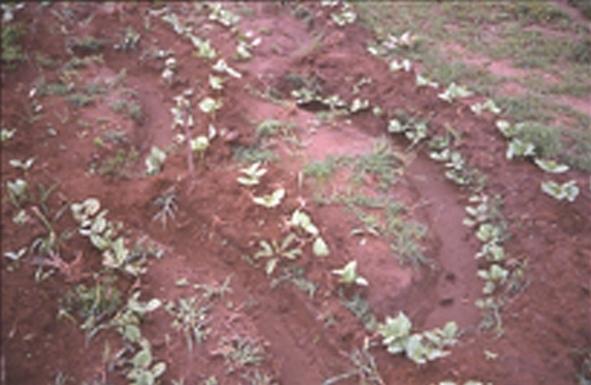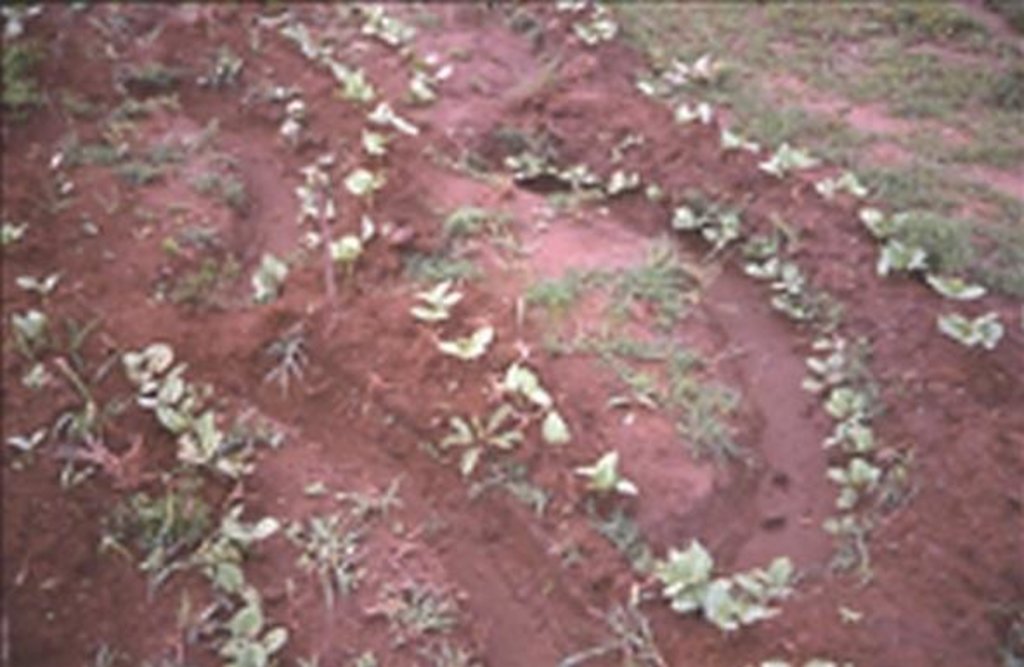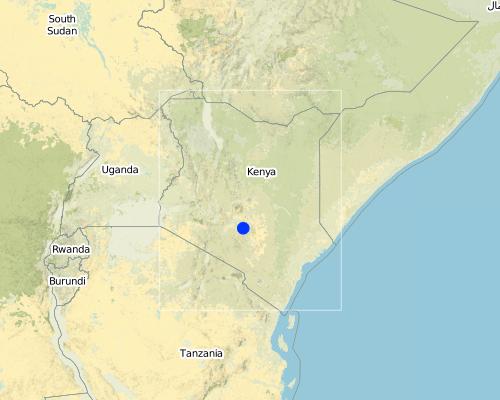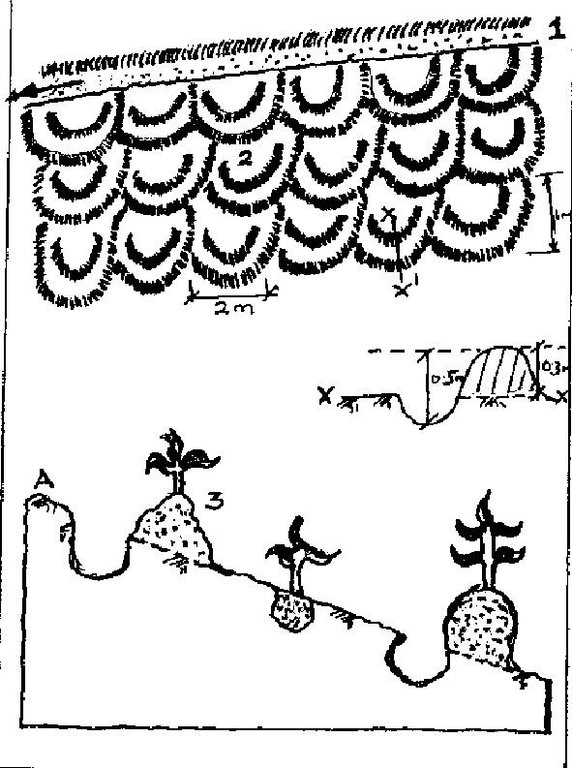Pitting - Machakos experience [肯尼亚]
- 创建:
- 更新:
- 编制者: Paul Mutuku Kimeu
- 编辑者: –
- 审查者: David Streiff
Wamatengo pits, Kitui Pitting, Katumani pitting
technologies_1484 - 肯尼亚
查看章节
全部展开 全部收起1. 一般信息
1.2 参与该技术评估和文件编制的资源人员和机构的联系方式
1.3 关于使用通过WOCAT记录的数据的条件
(现场)数据是什么时候汇编的?:
05/05/1999
编制者和关键资源人员接受有关使用通过WOCAT记录数据的条件。:
是
2. SLM技术的说明
2.1 技术简介
技术定义:
A system of interlocking crescent shaped trenches approximately 5-12 square metres, 0.5 m deep and 0.3 m high formed down slope using the xecavated spoil
2.2 技术的详细说明
说明:
The pitting is started at the top of the eroded slope or below a cutoff drain which interced all runoff from the above land. The pits are roughly circular in shape and are dug to form interlocking micro catchment, each about 2m squared in area. A semi circular bank 15 - 30cm high is constructed to the lower side of the pit using soil removed from the trench. At the centre of each trench, a hole is excavated to a depth of at least 50cm to act as the main reservoir for runoff water from the catchment above. The pit are used for soil conservation and rehabilitation of the grazingland. Runoff is captured in small quantities, thus preventing the build up of large erosive flows. Cowpeas, grass could be sown on the ridges at onset of the rains. Construction is by hoes and once the vegetation has established, maintenance is minimal. Forage should be cut and fed to animals. The technology is suitable in areas with 6-8% slope in areas with 500-800mm rainfall. There is need to maintain the cutoff drain after a rainy season
2.3 技术照片
2.5 已应用该技术的、本评估所涵盖的国家/地区/地点
国家:
肯尼亚
区域/州/省:
Eastern Province
Map
×2.6 实施日期
如果不知道确切的年份,请说明大概的日期:
- 不到10年前(最近)
2.7 技术介绍
详细说明该技术是如何引入的:
- 在实验/研究期间
注释(项目类型等):
based on similar technology from the neighbouring Kitui and also Tanzania (Matengo Pits)
3. SLM技术的分类
3.1 该技术的主要目的
- 减少、预防、恢复土地退化
3.2 应用该技术的当前土地利用类型

牧场
注释:
Major land use problems (compiler’s opinion): erosion in the unprotected grazing areas
Major land use problems (land users’ perception): lack of adequate fodder for livestock
Grazingland comments: there is an increasing trend towards closing off grazing areas to avoid interference by neighbours and to improve forage productivity.
Type of grazing system comments: there is an increasing trend towards closing off grazing areas to avoid interference by neighbours and to improve forage productivity.
3.3 有关土地利用的更多信息
该技术所应用土地的供水:
- 雨养
每年的生长季节数:
- 2
具体说明:
Longest growing period in days: 43 Longest growing period from month to month: Oct - DecSecond longest growing period in days: 34Second longest growing period from month to month: Mar - Jul
3.4 该技术所属的SLM组
- 引水和排水
3.5 技术传播
具体说明该技术的分布:
- 均匀地分布在一个区域
如果该技术均匀地分布在一个区域上,请注明覆盖的大致区域。:
- < 0.1 平方千米(10 公顷)
注释:
these were research trial plots.
3.6 包含该技术的可持续土地管理措施

结构措施
- S2:堤、岸
- S4:平沟、坑
注释:
Main measures: structural measures
3.7 该技术强调的主要土地退化类型

土壤水蚀
- Wt:表土流失/地表侵蚀

化学性土壤退化
- Cn:肥力下降和有机质含量下降(非侵蚀所致)

水质恶化
- Ha:干旱化
注释:
Main type of degradation addressed: Wt: loss of topsoil / surface erosion, Ha: aridification
Secondary types of degradation addressed: Cn: fertility decline and reduced organic matter content
3.8 防止、减少或恢复土地退化
具体数量名该技术与土地退化有关的目标:
- 减少土地退化
4. 技术规范、实施活动、投入和成本
4.1 该技术的技术图纸
4.2 技术规范/技术图纸说明
Technical knowledge required for field staff / advisors: moderate
Technical knowledge required for land users: moderate
Main technical functions: control of dispersed runoff: retain / trap, improvement of ground cover, water harvesting / increase water supply
Secondary technical functions: control of raindrop splash, increase in organic matter, increase of infiltration
Construction material (earth): this is the spoil obtained from the excavation
Vegetation is used for stabilisation of structures.
Change of land use type: during establishment of grass/legume
4.3 有关投入和成本计算的一般信息
其它/国家货币(具体说明):
Kenya Shilling
注明美元与当地货币的汇率(如相关):1美元=:
78.0
注明雇用劳工的每日平均工资成本:
2.56
4.4 技术建立活动
| 活动 | 措施类型 | 时间 | |
|---|---|---|---|
| 1. | reseeding grass | 结构性的 | rainy days |
| 2. | pit excavation | 结构性的 | before rains |
| 3. | bund formation | 结构性的 | before rains |
| 4. | legume planting | 结构性的 | before rains |
| 5. | fencing | 管理 | before rains |
4.5 技术建立所需要的费用和投入
注释:
Duration of establishment phase: 36 month(s)
4.6 维护/经常性活动
| 活动 | 措施类型 | 时间/频率 | |
|---|---|---|---|
| 1. | repair pits | 结构性的 | after rains/twice |
| 2. | desilt of cutoff drains | 结构性的 | before rains/each cropping season |
| 3. | sealing gaps on the fence | 管理 | during the rain / twice |
4.7 维护/经常性活动所需要的费用和投入(每年)
注释:
the costs were calculated based on the construction of a cutoff drain, fencing and pits
4.8 影响成本的最重要因素
描述影响成本的最决定性因素:
when cutoff drain is to be constructed, particularly in the dry spell when the ground is hard. When the construction is done when the ground is too hard the cost of labour is high.
5. 自然和人文环境
5.1 气候
年降雨量
- < 250毫米
- 251-500毫米
- 501-750毫米
- 751-1,000毫米
- 1,001-1,500毫米
- 1,501-2,000毫米
- 2,001-3,000毫米
- 3,001-4,000毫米
- > 4,000毫米
农业气候带
- 半干旱
Thermal climate class: tropics
5.2 地形
平均坡度:
- 水平(0-2%)
- 缓降(3-5%)
- 平缓(6-10%)
- 滚坡(11-15%)
- 崎岖(16-30%)
- 陡峭(31-60%)
- 非常陡峭(>60%)
地形:
- 高原/平原
- 山脊
- 山坡
- 山地斜坡
- 麓坡
- 谷底
垂直分布带:
- 0-100 m a.s.l.
- 101-500 m a.s.l.
- 501-1,000 m a.s.l.
- 1,001-1,500 m a.s.l.
- 1,501-2,000 m a.s.l.
- 2,001-2,500 m a.s.l.
- 2,501-3,000 m a.s.l.
- 3,001-4,000 m a.s.l.
- > 4,000 m a.s.l.
5.3 土壤
平均土层深度:
- 非常浅(0-20厘米)
- 浅(21-50厘米)
- 中等深度(51-80厘米)
- 深(81-120厘米)
- 非常深(> 120厘米)
土壤质地(表土):
- 中粒(壤土、粉土)
- 细粒/重质(粘土)
表土有机质:
- 中(1-3%)
- 低(<1%)
如有可能,附上完整的土壤描述或具体说明可用的信息,例如土壤类型、土壤酸碱度、阳离子交换能力、氮、盐度等。:
Soil depth on average: Also moderatly
Soil fertility: Very low - medium
Soil water storage capacity: Medium - high
5.6 应用该技术的土地使用者的特征
非农收入:
- > 收入的50%
相对财富水平:
- 贫瘠
- 平均水平
说明土地使用者的其他有关特征:
Population density: 100-200 persons/km2
Annual population growth: 3% - 4%
5% of the land users are rich and own 30% of the land.
25% of the land users are average wealthy and own 35% of the land.
45% of the land users are poor and own 25% of the land.
20% of the land users are poor and own 10% of the land.
Off-farm income specification: most of the adult have moved to town to look for employment.
5.8 土地所有权、土地使用权和水使用权
土地所有权:
- 个人,未命名
- 个人,有命名
土地使用权:
- 个人
6. 影响和结论性说明
6.1 该技术的现场影响
生态影响
土壤
土壤流失
SLM之前的数量:
20.5
SLM之后的数量:
7
6.4 成本效益分析
技术收益与技术建立成本相比如何(从土地使用者的角度看)?
短期回报:
稍微积极
长期回报:
积极
技术收益与技术维护成本/经常性成本相比如何(从土地使用者的角度看)?
短期回报:
积极
长期回报:
积极
6.5 技术采用
如若可行,进行量化(住户数量和/或覆盖面积):
NA
注释:
Comments on acceptance with external material support: estimates
7. 参考和链接
7.2 参考可用出版物
标题、作者、年份、ISBN:
some aspects of soil conservation on grazing lands in Thomas , D B et al. SWC in Kenya. 1989.
链接和模块
全部展开 全部收起链接
无链接
模块
无模块






